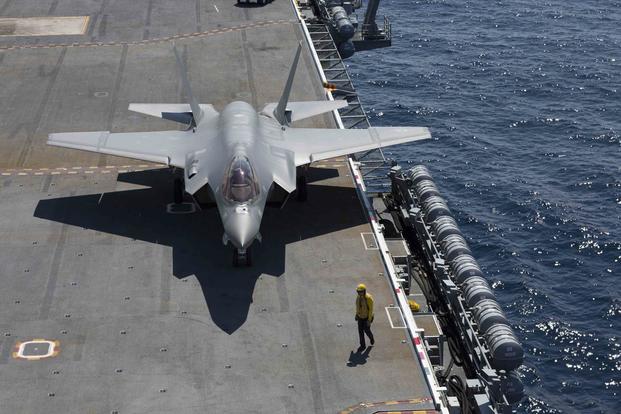The Government Accountability Office told lawmakers today that the Navy and Marine Corps may have difficulty meeting Defense Secretary James Mattis' goal of an 80 percent readiness rate for aircraft by next year.
John Pendleton, director of the GAO's Defense Capabilities and Management Team testified Wednesday before a joint hearing of the Senate Armed Service Committee's subcommittees on Seapower and Readiness and Management Support.
"The secretary of defense has established a goal to have 80 percent mission capability of several aircraft including the F-35 by next year -- this will be difficult to achieve in my assessment," Pendleton said.
In a report earlier this year, the GAO looked at seven different Navy and Marine Corps aircraft and none were meeting availability goals, set at less than 80 percent, Pendleton said.
"Many that had delays in depots were due to personnel and part shortages and unexpected repairs due to their age," he said. "As you know, the Hornet and the Harrier and other aircraft are 20 or more years [old], and we are having to extend their service life to [bridge] the gap until more F-35s come into the fleet."
In addition, early assessments of incorporating the F-35 into the fleet have revealed challenges for sustainment of the futuristic aircraft, Pendleton said.
"I understand the rush to field the F-35, and I know the Navy and the Marine Corps and [the Defense Department] are working on this, but I feel that additional attention has to be paid to sustaining the F-35," he said.
Sen. Tim Kaine, D-Virginia, said reaching 80 percent is a "lofty goal."
"It's a stretch goal ... but it's the kind of goal [that] you need to do good work," Kaine said. "While I support the goal, I do have concerns about how we come up with and allocate the resources that we need to meet it."
Sen. Mazie Hirono, D-Hawaii, asked if 80 percent was too high. "Are we being realistic in expecting ... 80 percent readiness?" she questioned.
Secretary of the Navy Richard Spencer said the Navy is taking on the challenge.
"It is a stretch goal senator, but it is a stretch goal that we will take," Spencer said.
"If I could bring you out to one of our depots to show you what we are doing -- it's program for the FA-18 Super Hornet. We have hired a fellow who ran Southwest Airlines maintenance. In eight weeks, we have increased throughput by 40 percent."
Hirono voiced concerns that the Navy might use "something that is called 'innovative accounting techniques' to indicate to us that these 80 percent goals are being met."
"Can you assure us that that is not what you are going to provide us?" she asked.
"It's not going to be done by pencil whipping, I will tell you that," Spencer assured.
Sen. Mike Rounds, R-South Dakota, said he has found some of the numbers on aircraft mission capable rates "disturbing."
Rounds asked why the Navy FA-18 E and F model Super Hornets have a mission capable rate of 49.1 percent and the Marine Corps' older Hornets are at a 60 percent mission capable rate.
Adm. William Moran, vice chief of naval operations, said those are likely older numbers.
"We are on the path to this stretch goal ... of 80 percent; last year, when I testified, we were in the mid-40s," he said. "Our current statistics on the ... mission capability rate for Super Hornets in operational squadrons that would have to go the fight if called, is at 66 percent and rising."
-- Matthew Cox can be reached at matthew.cox@military.com.












